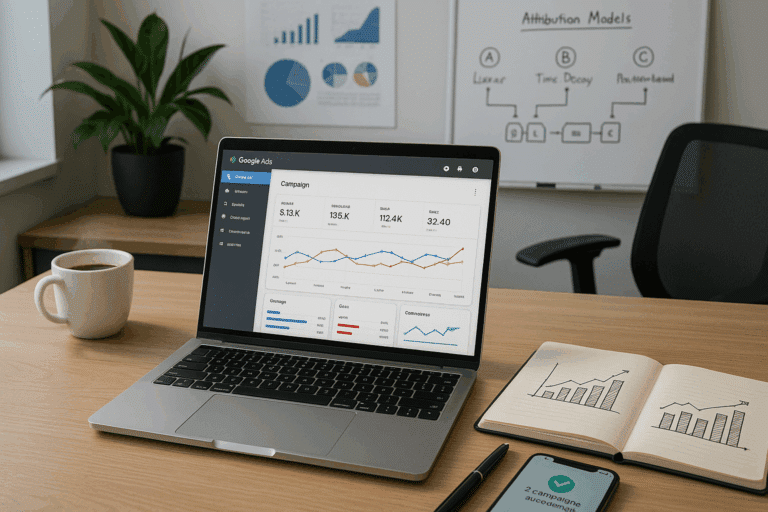This intricate process, known as attribution, serves as the compass guiding small businesses towards effective marketing strategies.🧭
Unlocking this information can be like finding a golden key that opens up a treasure chest of insights. However, it’s not just about merely collecting data – but making sense of it. It involves attributing value to each touchpoint in the customer journey, which can help small businesses optimise their marketing efforts, allocate resources more effectively, and ultimately boost their bottom line. 💼💰
With the rapid rise of digital marketing, attribution has become more complex, yet more critical than ever before. Customers interact with your business through numerous channels, from social media to email, to your website, and even offline. Identifying which channels are driving conversions and revenue can be a daunting task, but it’s a crucial one for small businesses wanting to compete effectively in the digital age. 📊🌐
Despite its importance, many businesses struggle with implementing a successful attribution model. This is often due to a lack of understanding of the concept, the numerous attribution models available, and how to apply them effectively. This article aims to demystify the world of attribution and provide small businesses with practical insights into how to harness this powerful tool for success. 👩💼🔧
Unlocking Success Through Attribution: The What, Why, and How 🗝️
Before we delve into the heart of attribution and its implementation, it’s important to understand its fundamental role in marketing. It’s about connecting the dots – linking customer interactions to conversions and using this information to inform future marketing efforts.
Throughout this article, we’ll be discussing the different types of attribution models, the advantages and pitfalls of each, and how to choose the right model for your business. We’ll also explore how to implement attribution effectively and the tools you can use to do this. 🛠️
Whether you’re a small business owner, a marketing professional, or just interested in the concept, this comprehensive guide is for you. Ready to unlock success through understanding attribution? Let’s dive in. 🏊♂️
Understanding Attribution Models: The Foundation of Your Marketing Strategy 🎯
Attribution models play a pivotal role in determining your marketing strategy. They allow you to assign credit to different touchpoints in the customer journey, thereby providing insight into which channels are most effective at driving conversions.
We’ll be looking at the most common attribution models, including first-touch, last-touch, linear, and time-decay models. Each has its strengths and weaknesses, and the choice of model will depend on your business’s unique needs and goals. 🎯
So, are you ready to unlock the power of attribution and propel your small business to new heights? Stay tuned, as we unravel the intricate web of attribution and its pivotal role in today’s dynamic business landscape. 🚀
Introduction: Why Attribution Matters for Small Businesses
As a small business, understanding where your customers are coming from is crucial. This understanding, known as attribution, is key to refining your marketing strategy and ultimately driving more sales. In today’s digital age, customers interact with your business across various touchpoints – from social media platforms to your website, emails, and more. Tracking these interactions can offer invaluable insights into what is working and what is not, thereby empowering you to make data-driven decisions and optimize your marketing efforts.
Before delving deeper, let’s take a moment to understand what attribution truly means in the context of marketing. Simply put, attribution is the process of identifying and assigning credit to the different marketing channels that have played a role in a customer’s journey, leading them to a purchase or conversion. It is a critical component of any successful marketing strategy, enabling you to understand which of your marketing efforts are paying off.
Given the multiplicity of customer touchpoints today, accurate attribution can be challenging. Nevertheless, with the right tools and approach, small businesses can effectively track customer interactions and leverage attribution data to drive growth. In the following sections, we will explore how you can accomplish this. But first, let’s start with a fundamental question: why is attribution so crucial for small businesses?
The Importance of Attribution for Small Businesses
Without accurate attribution, you’re essentially navigating your marketing strategy blindfolded. You’re spending money and resources on various marketing channels, but without knowing which ones are truly driving results, your marketing efforts can quickly become inefficient and wasteful.
For small businesses with limited resources, this can be particularly detrimental. Every penny counts, and knowing where to allocate your marketing budget can make a significant difference in your return on investment (ROI). That’s where attribution comes in. By providing visibility into the customer journey, attribution allows you to identify which marketing channels are contributing to conversions and adjust your strategy accordingly.
Moreover, attribution can help you understand your customers better. By tracking their interactions, you can gain insights into their preferences, behaviors, and decision-making processes, enabling you to tailor your marketing efforts to better meet their needs and desires. This customer-centric approach can lead to higher engagement, customer loyalty, and ultimately, sales.
💡 Tip: For an informative and practical guide on implementing marketing attribution, check out the YouTube video “Marketing Attribution in Five Steps” by Google Analytics.
How to Implement Attribution in Your Small Business
Now that we understand why attribution is crucial for small businesses, the question becomes: how can you implement it in your own business? This involves three key steps: selecting an attribution model, leveraging the right tools, and analyzing your attribution data.
First, it’s important to choose an attribution model that fits your business. Different models assign credit to marketing channels in different ways. For instance, the Last Click model assigns all credit to the final touchpoint before a conversion, while the Linear model assigns equal credit to all touchpoints. The model you choose will depend on your business and marketing strategy. To help you decide, let’s compare some of the most commonly used models in the following table:
| Attribution Model | Description | Best for… |
|---|---|---|
| Last Click | Credits the final touchpoint before a conversion. | Businesses with a short, straightforward customer journey. |
| First Click | Credits the first touchpoint that led the customer to your business. | Businesses focused on increasing awareness and acquisition. |
| Linear | Assigns equal credit to all touchpoints. | Businesses with a long, complex customer journey involving multiple touchpoints. |
| Time Decay | Assigns more credit to touchpoints closer to the conversion. | Businesses with a sales cycle where the final stages are critical. |
| Position Based | Assigns more credit to the first and last touchpoints, and divides the rest equally among other touchpoints. | Businesses that value both awareness and conversion equally. |
Once you’ve chosen your model, the next step is to leverage the right tools to track and attribute customer interactions. This can range from Google Analytics, a powerful and free tool that offers various attribution models, to more advanced solutions like Adobe Analytics or Mixpanel. These tools can help you collect, organize, and visualize your attribution data, making it easier to draw insights and make informed decisions.
Finally, it’s crucial to regularly analyze your attribution data and adjust your marketing strategy accordingly. Attribution is not a one-time effort but an ongoing process. It requires continuous monitoring and optimization to ensure your marketing efforts are effectively driving conversions and maximizing ROI.
Boost Your Marketing Strategy with Attribution
In conclusion, attribution is a powerful tool for small businesses. It provides visibility into the customer journey, allowing you to identify which marketing channels are driving conversions and optimize your marketing strategy accordingly. By implementing attribution in your business, you can make more data-driven decisions, improve your marketing efficiency, and ultimately boost your bottom line.
So, if you’re not already tracking customer interactions and attributing conversions, now is the time to start. Check out the resources mentioned in this article, choose an attribution model that fits your business, leverage the right tools, and start making the most of your marketing data. Your business will thank you for it.
🔎 Explore more on this topic by watching “Understanding Marketing Attribution” by HubSpot Academy on YouTube.
Final Thoughts: The Power of Attribution
Attribution is more than just a buzzword in the world of digital marketing; it’s a key to unlocking success for small businesses. By providing a clear view of what’s working and what’s not, attribution allows you to make informed decisions, optimize your marketing efforts, and achieve a higher return on investment.
However, the journey doesn’t end here. As with any marketing strategy, continuous learning and optimization are crucial. Keep testing, analyzing, and adjusting your strategy based on your attribution data. Remember, the goal is not just to drive conversions, but to build lasting relationships with your customers and create a customer journey that is as seamless and enjoyable as possible.
So take the leap, start tracking your customer interactions today, and unlock the power of attribution for your small business. The success you achieve will be worth the effort.
👀 Don’t forget to watch “Why Attribution Matters” by Facebook Business on YouTube for more insights and tips on leveraging attribution in your business.

Conclusion
In conclusion, the points discussed throughout this article illustrate the indispensable role that Software Engineering plays in today’s digital age. We have navigated through complex concepts and technical details, endeavouring to make them as understandable as possible.
Firstly, we delved into the integral aspects of software engineering. We highlighted the importance of system analysis, design, coding, testing, maintenance and more, explaining how each phase in the software development life cycle (SDLC) contributes to the creation of a robust and efficient system. (source)
Secondly, we touched upon the various methodologies used in software engineering. From the traditional Waterfall Model to the iterative Agile Model, we discussed how these methodologies provide a structured approach to software development, each with their own unique set of advantages. (source)
Additionally, we talked about the importance of quality assurance in software engineering. How crucial it is to maintain standards and guidelines to ensure the software product meets specified requirements and user expectations. We also explored different testing techniques and their significance in finding and fixing defects before the software is deployed. (source)
Moreover, we emphasized the importance of software maintenance, discussing the various types of maintenance tasks such as corrective, adaptive, perfective and preventive, and their role in keeping the software system up-to-date and efficient. (source)
Lastly, we examined some of the ethical issues in software engineering. We underscored the need for software engineers to adhere to a code of ethics and professional conduct, to ensure the wellbeing of society and maintain the integrity of the profession. (source)
The world of software engineering is dynamic and constantly evolving. With advancements in technology, the demand for high-quality, efficient software systems is ever increasing. Hence, it is of paramount importance to stay updated and continuously improve your skills in this field.
Your understanding and application of the knowledge shared in this article will not only enhance your expertise but also help you contribute effectively in this fast-paced technological era. Therefore, I encourage you to apply what you’ve learnt, share your thoughts and experiences, and engage in conversations that fuel growth and innovation. 🚀
I hope this article has been insightful and beneficial to you. If you have any questions, suggestions or feedback, please feel free to comment below. Let’s keep the conversation going. Remember, learning is a continuous process and your participation matters! 🌱
I look forward to your valuable insights and discussions. Until next time, happy learning and keep pushing the boundaries of innovation!💡
References:
1. GeeksforGeeks
2. TutorialsPoint
3. Guru99
4. GeeksforGeeks
5. Computer.org



